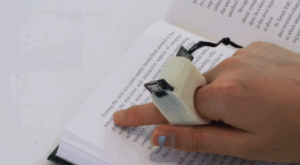In recent years, it’s been noted that fewer than 10 percent of legally blind Americans read Braille. And with this number steadily declining as the use of technology increases, what other options are available? With advancements in technology, there are several devices already available to help individuals with visual impairments read. However, individuals often encounter the two following predicaments:
1. Devices may only magnify text and lack any accompanying audio;
2. Devices may provide both magnification and audio but may be unwieldy, therefore limiting use outside of one’s home or office.
Scientists at the Massachusetts Institute of Technology have worked on a novel gadget, coined the FingerReader, which is a ring-like device worn on the index finger, that will help the visually impaired read virtually any text–print or electronic. In order to read desired text, the index finger is used to trace out a line onscreen or content written in a book.
The FingerReader features the following:
- Built-in camera and audio: when the user traces text with the index finger and FingerReader in place, the camera will identify the text and read it aloud in real time. This separates the FingerReader from many other devices because other devices don’t provide real-time functionality.
- Haptic feedback: as humans, we often rely on our senses to keep us focused. The FingerReader utilizes this by providing a subtle vibration, letting the user know when the line ends or that the finger has strayed off course.
One should note, the FingerReader is not designed to replace the Braille system, which was developed in 1829. But it does offer the following benefits:
- For individuals who become visually impaired later in life, learning Braille may be very challenging. The device grants these individuals the opportunity to continue to read and obtain knowledge through text without having to learn Braille.
- Not all texts are readily available in Braille format. The FingerReader essentially opens up a whole new world by making newspapers, magazines, books, computer screens, etc., all accessible to the visually impaired.

